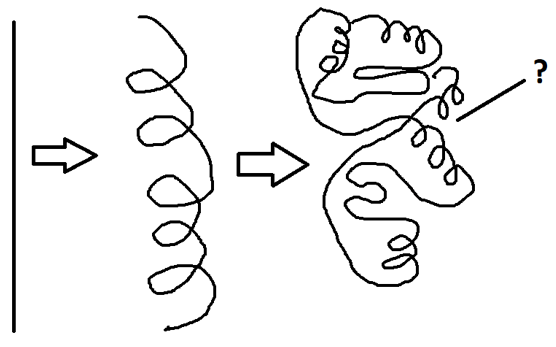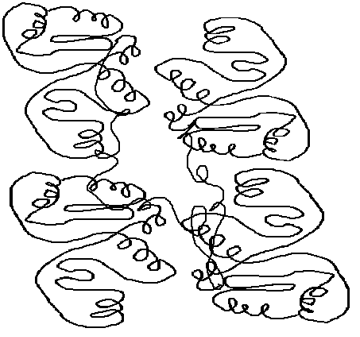This set of Class 11 Biology Chapter 9 Multiple Choice Questions & Answers (MCQs) focuses on “Biomolecules – Structure of Proteins-2” for Medical Entrance Exams.
1. What type of helix is observed in proteins?
a) Left-handed helix
b) Parallel double helix
c) Antiparallel double helix
d) Right-handed helix
View Answer
Explanation: The secondary structure of proteins is in the form of a single helix. It is formed by the folding of the primary structure. Anti-parallel double-stranded helix is found in DNA. Proteins always possess a right-handed helix.
2. Which of these statements is true about the secondary structure of proteins?
a) Secondary structure of protein occurs only in the form of helices
b) Protein helices are always double-stranded
c) Protein helices and right-handed
d) Entire primary structure of the protein is folded into a helix
View Answer
Explanation: Protein helices are always right-handed. The secondary structure occurs in the form of helices and sheets. They are always single stranded and only parts of the protein chain is folded into helices.
3. Which of these structures is necessary for the activity of proteins?
a) Alpha–helix
b) Primary structure
c) Tertiary structure
d) Beta–sheet
View Answer
Explanation: The tertiary structure is necessary for the activity of protein inside the body to perform various functions such as enzymatic activity, hormonal control, cell division and the normal development and maintenance of the body.
4. Which of these structures is three-dimensional?
a) Tertiary structure
b) Primary structure
c) Alpha–helix
d) Beta–sheet
View Answer
Explanation: The primary structure of proteins consists of a long chain of amino acids. The secondary structure of proteins which consists of helices and sheets is also a two-dimensional structure. However, the tertiary structure of proteins is a three-dimensional structure.
5. Identify the level of organization of the polypeptide.

a) Quaternary
b) Secondary
c) Primary
d) Tertiary
View Answer
Explanation: The given diagram shows an Alpha helix. Alpha helix is a type of secondary structure of proteins. Therefore, the level of organization of the given polypeptide chain is secondary. It is formed by the folding of the primary structure.
6. Which of these structures have more than one polypeptide chain?
a) Primary
b) Tertiary
c) Quaternary
d) Secondary
View Answer
Explanation: Quaternary structures of proteins consist of more than one polypeptide chain or subunits. It is formed by the association and different arrangements of polypeptides chains with each other.
7. Which of these levels of organization does hemoglobin possess?
a) Quaternary
b) Tertiary
c) Secondary
d) Primary
View Answer
Explanation: Hemoglobin possesses four subunits-two alpha subunits and two beta subunits. Since hemoglobin is made of more than one subunit or polypeptide chain, it possesses a quaternary structure.
8. How many subunits does human hemoglobin contain?
a) 2
b) 3
c) 6
d) 4
View Answer
Explanation: Adult human hemoglobin is composed of four subunits – two alpha subunits and two beta subunits. Hemoglobin is an iron-containing metalloprotein present in red blood cells for gaseous transport.
9. How many types of subunits does hemoglobin possess?
a) 1
b) 4
c) 2
d) 3
View Answer
Explanation: Adult human hemoglobin is composed of four subunits-two alpha subunits and two beta subunits. Two subunits are of alpha type while two subunits are of beta type. Hence, it has two types of subunits.
10. Tertiary structure gives a three-dimensional view of proteins. True or false?
a) True
b) False
View Answer
Explanation: Tertiary structures are formed by the folding of primary structure and further folding of secondary structures. The tertiary structure hence formed gives us a three-dimensional view of the protein.
11. Identify the structure.

a) Primary structure
b) Quaternary structure
c) Secondary structure
d) Tertiary structure
View Answer
Explanation: The structure labelled in the diagram is the tertiary structure. Tertiary structures are formed by the folding of the linear primary structure and by the further folding of secondary structures.
12. Identify the level of organization of the protein.

a) Primary
b) Tertiary
c) Quaternary
d) Secondary
View Answer
Explanation: The given protein in the diagram has a quaternary level of organization. This can be understood by observing four subunits which are distinct from each other. It is the highest level of organization.
13. Which level of organization do beta sheets belong to?
a) Primary
b) Quaternary
c) Secondary
d) Tertiary
View Answer
Explanation: Beta sheets and alpha helices are forms of the secondary level of organization of proteins.
14. In which of these structures of proteins can disulfide bonds be found?
a) Tertiary structure
b) Alpha helix
c) Beta sheet
d) Primary structure
View Answer
Explanation: Tertiary structures are formed by the folding of the linear primary structure and by the further folding of secondary structures. These structures re three-dimensional and are characterized by interactions such as disulfide bonds.
15. How many beta subunits are present in human hemoglobin?
a) 1
b) 2
c) 3
d) 4
View Answer
Explanation: Adult human hemoglobin is composed of four subunits-two alpha subunits and two beta subunits. Hemoglobin is an iron-containing metalloprotein which has a quaternary level of organization.
Sanfoundry Global Education & Learning Series – Biology – Class 11.
To practice Biology MCQs for Medical Entrance Exams, here is complete set of 1000+ Multiple Choice Questions and Answers.
If you find a mistake in question / option / answer, kindly take a screenshot and email to [email protected]
- Practice Class 11 - Mathematics MCQs
- Check Class 11 - Books
- Practice Class 11 - Chemistry MCQs
- Practice Class 11 - Physics MCQs
- Practice Class 12 - Biology MCQs
